2012 VOLKSWAGEN TOUAREG Collision
[x] Cancel search: CollisionPage 418 of 684
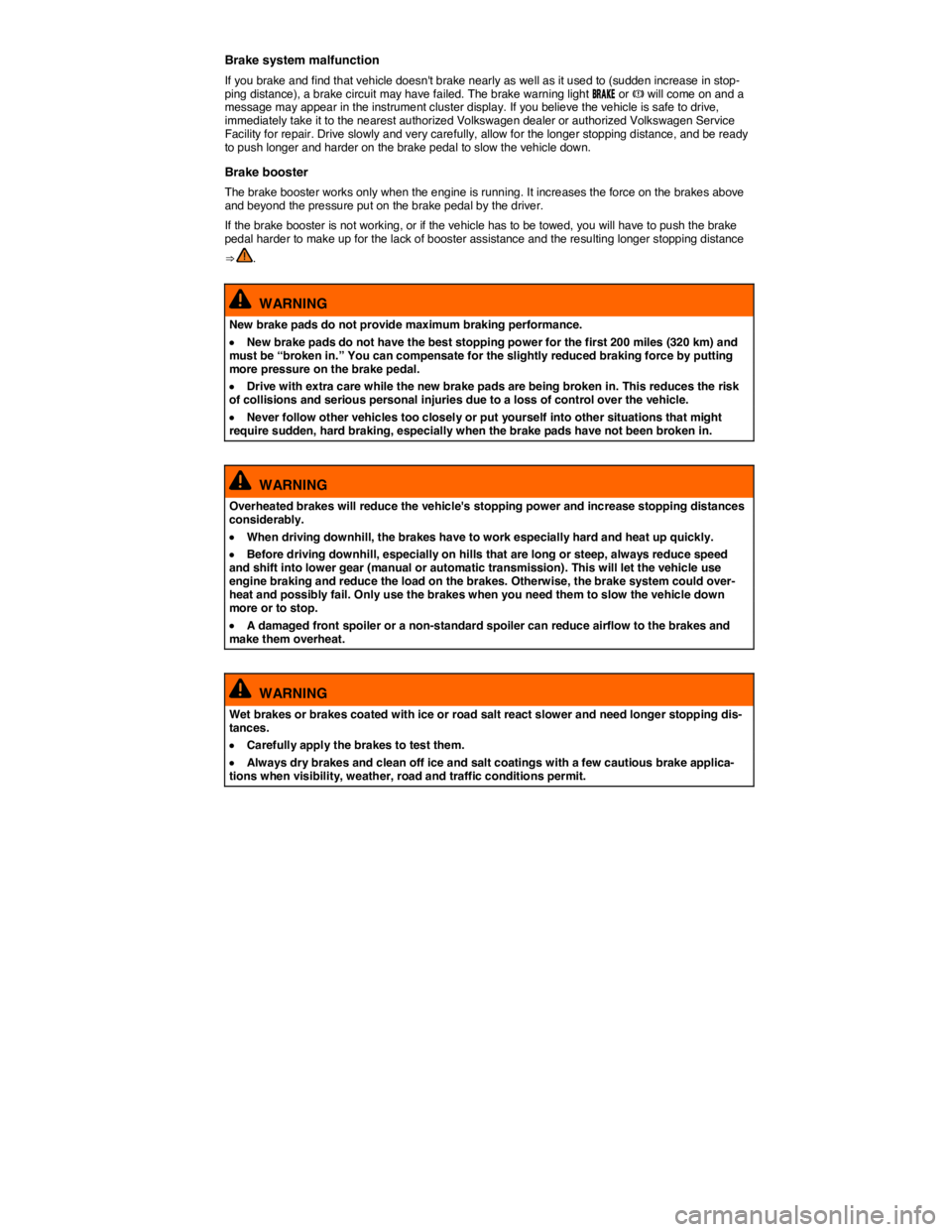
Brake system malfunction
If you brake and find that vehicle doesn't brake nearly as well as it used to (sudden increase in stop-ping distance), a brake circuit may have failed. The brake warning light �"�2�!�+�% or �H will come on and a message may appear in the instrument cluster display. If you believe the vehicle is safe to drive, immediately take it to the nearest authorized Volkswagen dealer or authorized Volkswagen Service Facility for repair. Drive slowly and very carefully, allow for the longer stopping distance, and be ready to push longer and harder on the brake pedal to slow the vehicle down.
Brake booster
The brake booster works only when the engine is running. It increases the force on the brakes above and beyond the pressure put on the brake pedal by the driver.
If the brake booster is not working, or if the vehicle has to be towed, you will have to push the brake pedal harder to make up for the lack of booster assistance and the resulting longer stopping distance
⇒ .
WARNING
New brake pads do not provide maximum braking performance.
�x New brake pads do not have the best stopping power for the first 200 miles (320 km) and must be “broken in.” You can compensate for the slightly reduced braking force by putting more pressure on the brake pedal.
�x Drive with extra care while the new brake pads are being broken in. This reduces the risk of collisions and serious personal injuries due to a loss of control over the vehicle.
�x Never follow other vehicles too closely or put yourself into other situations that might require sudden, hard braking, especially when the brake pads have not been broken in.
WARNING
Overheated brakes will reduce the vehicle's stopping power and increase stopping distances considerably.
�x When driving downhill, the brakes have to work especially hard and heat up quickly.
�x Before driving downhill, especially on hills that are long or steep, always reduce speed and shift into lower gear (manual or automatic transmission). This will let the vehicle use engine braking and reduce the load on the brakes. Otherwise, the brake system could over-heat and possibly fail. Only use the brakes when you need them to slow the vehicle down more or to stop.
�x A damaged front spoiler or a non-standard spoiler can reduce airflow to the brakes and make them overheat.
WARNING
Wet brakes or brakes coated with ice or road salt react slower and need longer stopping dis-tances.
�x Carefully apply the brakes to test them.
�x Always dry brakes and clean off ice and salt coatings with a few cautious brake applica-tions when visibility, weather, road and traffic conditions permit.
Page 431 of 684
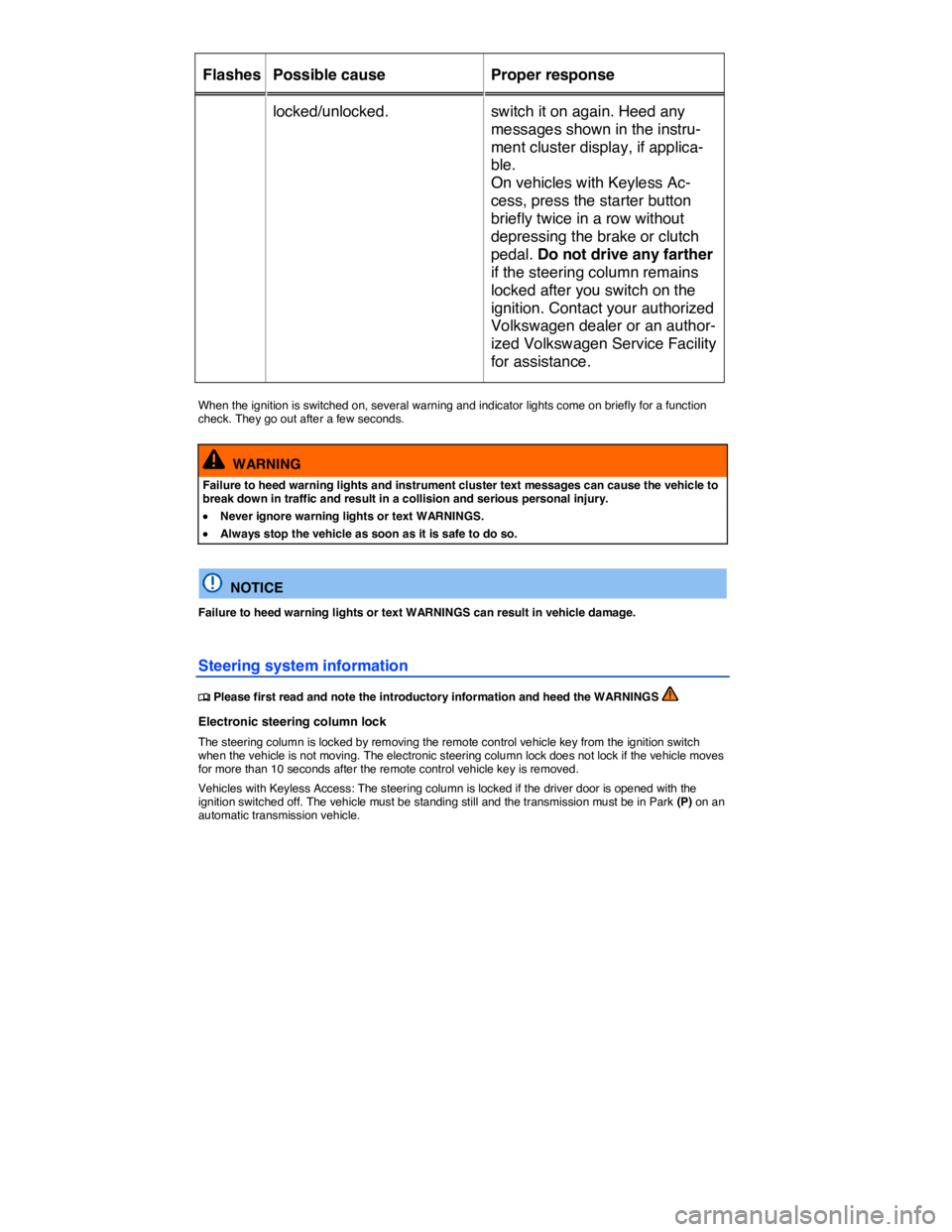
Flashes Possible cause Proper response
locked/unlocked. switch it on again. Heed any
messages shown in the instru-
ment cluster display, if applica-
ble.
On vehicles with Keyless Ac-
cess, press the starter button
briefly twice in a row without
depressing the brake or clutch
pedal. Do not drive any farther
if the steering column remains
locked after you switch on the
ignition. Contact your authorized
Volkswagen dealer or an author-
ized Volkswagen Service Facility
for assistance.
When the ignition is switched on, several warning and indicator lights come on briefly for a function check. They go out after a few seconds.
WARNING
Failure to heed warning lights and instrument cluster text messages can cause the vehicle to break down in traffic and result in a collision and serious personal injury.
�x Never ignore warning lights or text WARNINGS.
�x Always stop the vehicle as soon as it is safe to do so.
NOTICE
Failure to heed warning lights or text WARNINGS can result in vehicle damage.
Steering system information
�
Page 437 of 684
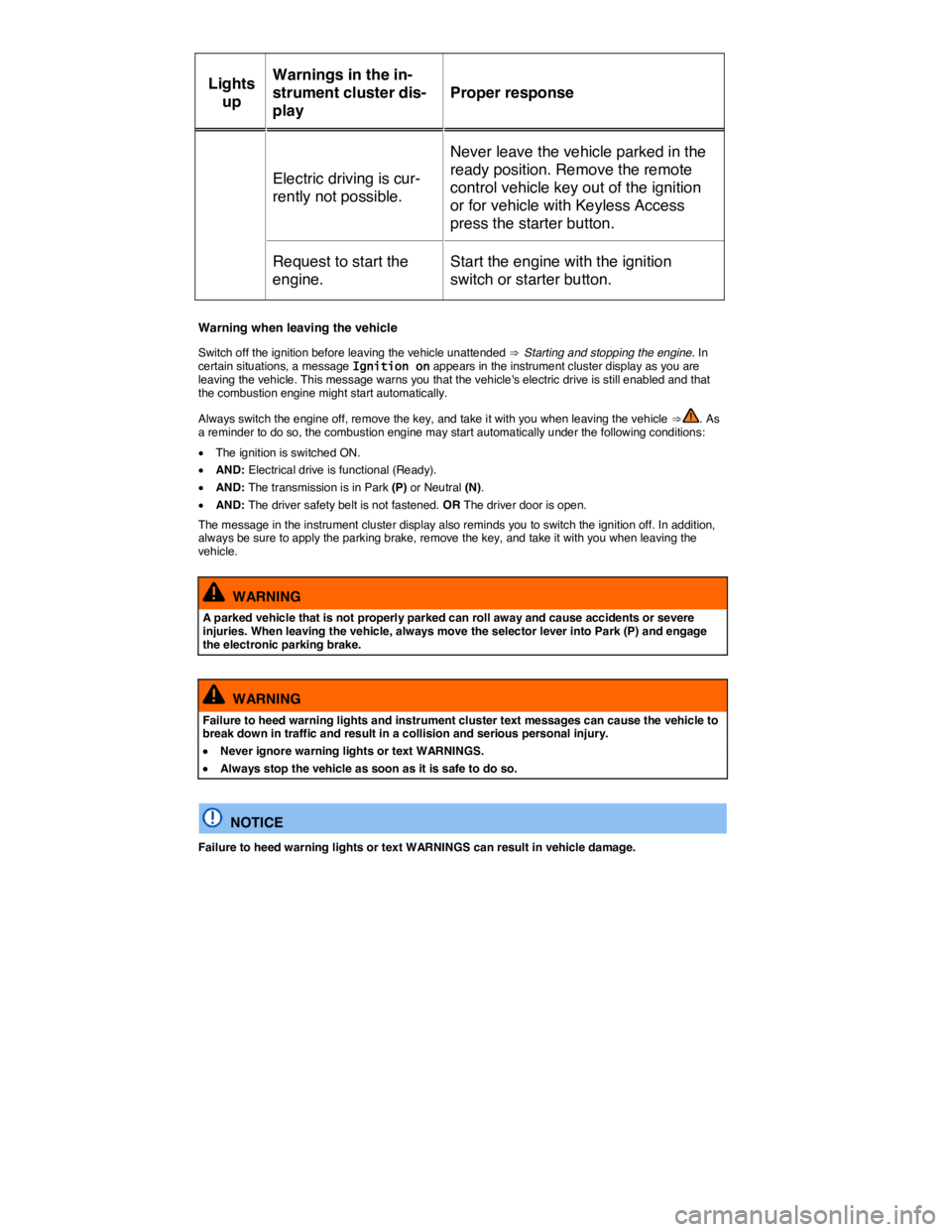
Lights
up
Warnings in the in-
strument cluster dis-
play
Proper response
Electric driving is cur-
rently not possible.
Never leave the vehicle parked in the
ready position. Remove the remote
control vehicle key out of the ignition
or for vehicle with Keyless Access
press the starter button.
Request to start the
engine.
Start the engine with the ignition
switch or starter button.
Warning when leaving the vehicle
Switch off the ignition before leaving the vehicle unattended ⇒ Starting and stopping the engine. In certain situations, a message Ignition on appears in the instrument cluster display as you are leaving the vehicle. This message warns you that the vehicle's electric drive is still enabled and that the combustion engine might start automatically.
Always switch the engine off, remove the key, and take it with you when leaving the vehicle ⇒ . As a reminder to do so, the combustion engine may start automatically under the following conditions:
�x The ignition is switched ON.
�x AND: Electrical drive is functional (Ready).
�x AND: The transmission is in Park (P) or Neutral (N).
�x AND: The driver safety belt is not fastened. OR The driver door is open.
The message in the instrument cluster display also reminds you to switch the ignition off. In addition, always be sure to apply the parking brake, remove the key, and take it with you when leaving the vehicle.
WARNING
A parked vehicle that is not properly parked can roll away and cause accidents or severe injuries. When leaving the vehicle, always move the selector lever into Park (P) and engage the electronic parking brake.
WARNING
Failure to heed warning lights and instrument cluster text messages can cause the vehicle to break down in traffic and result in a collision and serious personal injury.
�x Never ignore warning lights or text WARNINGS.
�x Always stop the vehicle as soon as it is safe to do so.
NOTICE
Failure to heed warning lights or text WARNINGS can result in vehicle damage.
Page 446 of 684
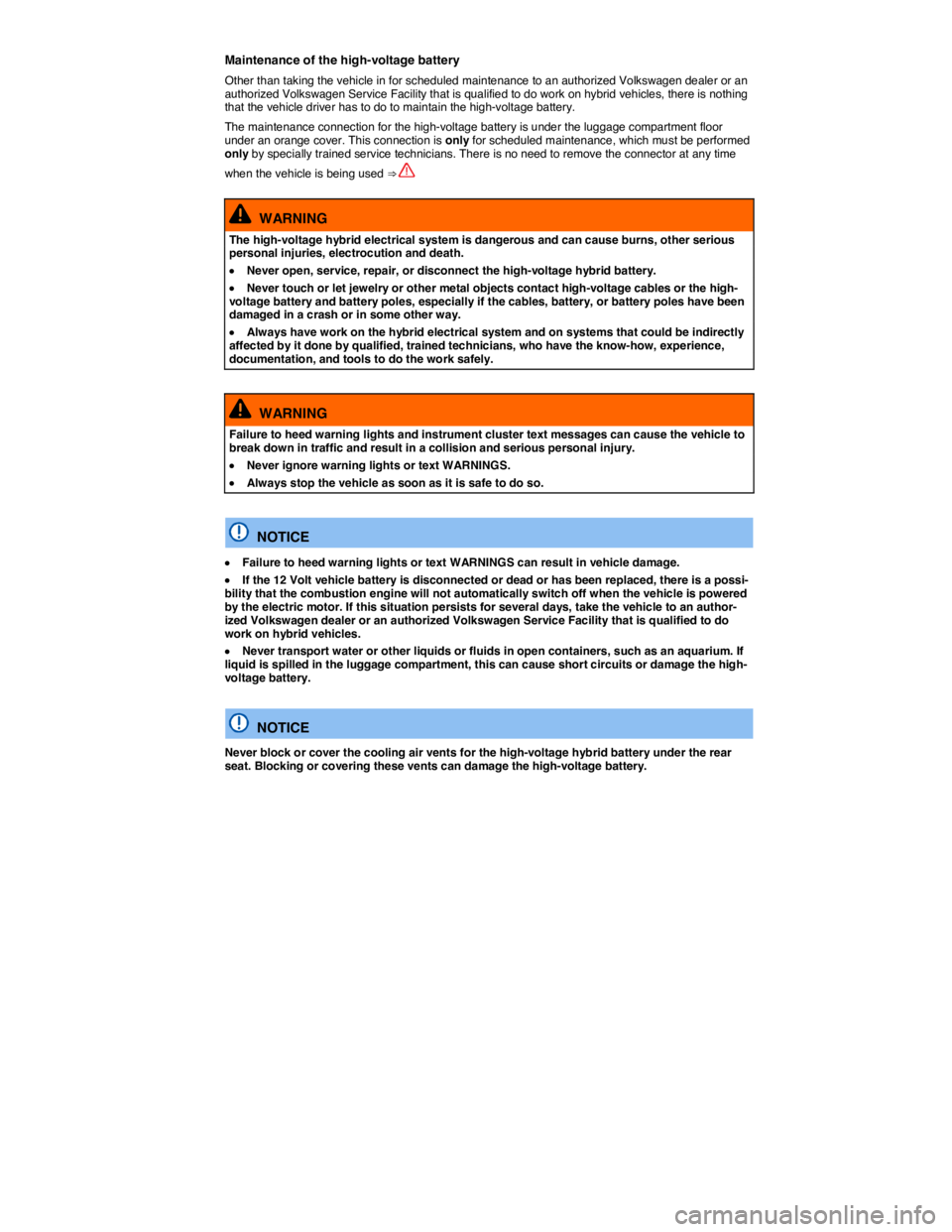
Maintenance of the high-voltage battery
Other than taking the vehicle in for scheduled maintenance to an authorized Volkswagen dealer or an authorized Volkswagen Service Facility that is qualified to do work on hybrid vehicles, there is nothing that the vehicle driver has to do to maintain the high-voltage battery.
The maintenance connection for the high-voltage battery is under the luggage compartment floor under an orange cover. This connection is only for scheduled maintenance, which must be performed only by specially trained service technicians. There is no need to remove the connector at any time
when the vehicle is being used ⇒
WARNING
The high-voltage hybrid electrical system is dangerous and can cause burns, other serious personal injuries, electrocution and death.
�x Never open, service, repair, or disconnect the high-voltage hybrid battery.
�x Never touch or let jewelry or other metal objects contact high-voltage cables or the high-voltage battery and battery poles, especially if the cables, battery, or battery poles have been damaged in a crash or in some other way.
�x Always have work on the hybrid electrical system and on systems that could be indirectly affected by it done by qualified, trained technicians, who have the know-how, experience, documentation, and tools to do the work safely.
WARNING
Failure to heed warning lights and instrument cluster text messages can cause the vehicle to break down in traffic and result in a collision and serious personal injury.
�x Never ignore warning lights or text WARNINGS.
�x Always stop the vehicle as soon as it is safe to do so.
NOTICE
�x Failure to heed warning lights or text WARNINGS can result in vehicle damage.
�x If the 12 Volt vehicle battery is disconnected or dead or has been replaced, there is a possi-bility that the combustion engine will not automatically switch off when the vehicle is powered by the electric motor. If this situation persists for several days, take the vehicle to an author-ized Volkswagen dealer or an authorized Volkswagen Service Facility that is qualified to do work on hybrid vehicles.
�x Never transport water or other liquids or fluids in open containers, such as an aquarium. If liquid is spilled in the luggage compartment, this can cause short circuits or damage the high-voltage battery.
NOTICE
Never block or cover the cooling air vents for the high-voltage hybrid battery under the rear seat. Blocking or covering these vents can damage the high-voltage battery.
Page 454 of 684

WARNING
Always remember that the Adaptive Cruise Control has limits – Using Adaptive Cruise Con-trol when it is not possible to drive safely at a constant speed can be dangerous and can lead to an accident and serious personal injury.
�x Adaptive Cruise Control will not slow the vehicle down or maintain the set distance when you drive towards an obstacle or something on or near the road that is not moving, such as vehicles stopped in a traffic jam, a stalled or disabled vehicle.
�x Always adjust your speed and the distance you keep between you and the vehicles ahead of you to the road, traffic, weather, and visibility conditions.
�x Never use Adaptive Cruise Control on steep, winding, or slippery roads (such gravel roads, wet roads, or snowy or icy roads) or on roads with standing water.
�x Never use Adaptive Cruise Control when driving in heavy or varying stop-and-go traffic.
�x Never use Adaptive Cruise Control when driving off-road or on unpaved roads.
�x Always remember that the Adaptive Cruise Control cannot detect a vehicle that is driving towards you in your traffic lane and that it cannot detect narrow vehicles such as motorcy-cles and bicycles.
�x Never follow a vehicle so closely that you cannot stop your vehicle safely. The Adaptive Cruise Control cannot slow or brake the vehicle safely when you follow another vehicle too closely. Always remember that the Adaptive Cruise Control has a braking power that is only about 30% of the vehicle's maximum braking ability, under certain circumstances the auto-matic braking function cannot bring the vehicle to a stop in time.
�x Always turn off Adaptive Cruise Control when entering turn lanes, exit lanes and construc-tion zones or in similar situations because the vehicle will automatically accelerate to the stored speed when the road ahead is clear.
�x To help prevent unintended operation of Adaptive Cruise Control, switch the system off when it is not being used.
�x It is dangerous to use the Resume feature when the previously set speed is too high for the existing road, traffic, or weather conditions.
�x When traveling downhill, the Adaptive Cruise Control may not be able to maintain a con-stant speed. The vehicle will speed up because of its own weight. Downshift and/or use the foot brake to slow the vehicle.
�x Never allow the closing speed between you and other vehicles to be so high that the Adaptive Cruise Control may not be able to slow your vehicle safely. If closing speed is too high, you must apply the brakes yourself to reduce the risk of a rear-end crash.
�x If a driver intervention warning appears in the instrument cluster display, immediately takeover the control of the brake and gas pedals and low down the vehicle or bring it to stop when necessary and according to the traffic situation.
�x If a Forward Collision Warning system (Front Assist) collision warning appears in the instrument cluster display, immediately takeover the control of the brake and gas pedals and low down the vehicle or bring it to stop when necessary and according to the traffic situation.
�x Always be prepared to takeover the control of the brake and the gas pedal in every situa-tion.
NOTICE
If you suspect that ACC and the Forward Collision Warning system (Front Assist) don't work properly or the sensors are damaged, switch off ACC immediately.
�x Go see an authorized Volkswagen dealer or Volkswagen Service Facility for assistance and have the ACC system checked.
Page 457 of 684

Lights
up Possible cause ⇒ Proper response
�E
Adaptive Cruise Control
(ACC) is not active, the sys-
tem is on but not regulating
or holding speed.
-
When the ignition is switched on, several warning and indicator lights come on briefly for a function check. They go out after a few seconds.
WARNING
Failure to heed warning lights and instrument cluster text messages can cause the vehicle to break down in traffic and result in a collision and serious personal injury.
�x Never ignore warning lights or text WARNINGS.
�x Always stop the vehicle as soon as it is safe to do so.
NOTICE
Failure to heed warning lights or text WARNINGS can result in vehicle damage.
Radar sensors, ultrasonic sensors and Front Assist camera
Fig. 271 Vehicle front view: Sensors and camera
�
Page 463 of 684
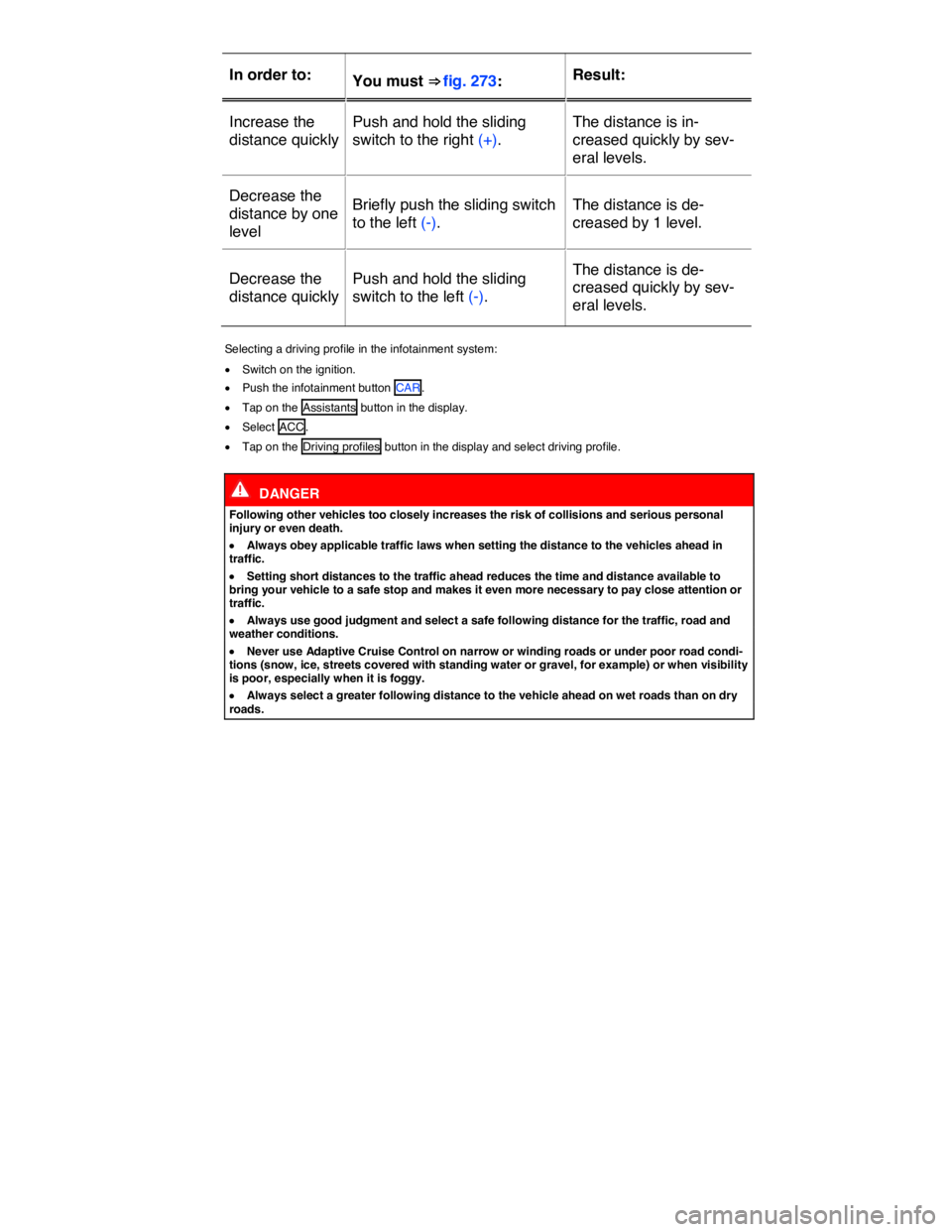
In order to: You must ⇒ fig. 273: Result:
Increase the
distance quickly
Push and hold the sliding
switch to the right (+).
The distance is in-
creased quickly by sev-
eral levels.
Decrease the
distance by one
level
Briefly push the sliding switch
to the left (-).
The distance is de-
creased by 1 level.
Decrease the
distance quickly
Push and hold the sliding
switch to the left (-).
The distance is de-
creased quickly by sev-
eral levels.
Selecting a driving profile in the infotainment system:
�x Switch on the ignition.
�x Push the infotainment button CAR.
�x Tap on the Assistants button in the display.
�x Select ACC.
�x Tap on the Driving profiles button in the display and select driving profile.
DANGER
Following other vehicles too closely increases the risk of collisions and serious personal injury or even death.
�x Always obey applicable traffic laws when setting the distance to the vehicles ahead in traffic.
�x Setting short distances to the traffic ahead reduces the time and distance available to bring your vehicle to a safe stop and makes it even more necessary to pay close attention or traffic.
�x Always use good judgment and select a safe following distance for the traffic, road and weather conditions.
�x Never use Adaptive Cruise Control on narrow or winding roads or under poor road condi-tions (snow, ice, streets covered with standing water or gravel, for example) or when visibility is poor, especially when it is foggy.
�x Always select a greater following distance to the vehicle ahead on wet roads than on dry roads.
Page 464 of 684

WARNING
Improper use of the Adaptive Cruise Control can cause collisions, other accidents and seri-ous personal injury.
�x Always remember that the Adaptive Cruise Control has limits – it will not slow the vehicle down or maintain the set distance when you drive towards an obstacle or something on or near the road that is not moving, such as vehicles stopped in a traffic jam, a stalled or disa-bled vehicle.
�x Always remember that the Adaptive Cruise Control cannot detect a vehicle that is driving towards you in your traffic lane and that it cannot detect narrow vehicles such as motorcy-cles and bicycles.
�x Never drive at speeds that are too fast for traffic, road and weather conditions.
�x Never follow a vehicle so closely that you cannot stop your vehicle safely. The Adaptive Cruise Control cannot slow or brake the vehicle safely when you follow another vehicle too closely. Always remember that the Adaptive Cruise Control has a braking power that is only about 30% of the vehicle's maximum braking ability, the automatic braking function cannot bring the vehicle to a stop.
�x Never use Adaptive Cruise Control when you cannot drive safely at a steady speed, in-cluding on city streets, on winding roads or when road conditions are poor (for example, on ice, gravel, in fog, heavy rain or on wet roads that increase the risk of hydroplaning).
�x The radar sensor's vision can be reduced by rain, snow and heavy road spray. These and similar conditions can prevent vehicles up ahead from being accurately detected and in some cases they may not be detected at all. Do not use ACC when the radar sensors cannot accu-rately detect vehicles moving ahead of you in traffic.
�x Always turn off Adaptive Cruise Control when entering turn lanes, exit lanes and construc-tion zones or in similar situations because the vehicle will automatically accelerate to the stored speed when the road ahead is clear.
�x Never rest your foot on the accelerator pedal, especially when the Adaptive Cruise Control is being used because doing so will override the braking function.
�x Always pay attention to traffic, especially when Adaptive Cruise Control is switched on.
�x Always maintain a safe speed and distance between your vehicle and other vehicles while considering the traffic situation. This is the duty of the driver. Adaptive Cruise Control is merely an aid to the driver.
�x To prevent unintended operation, always switch ACC off when it is not being used.
�x It is dangerous to use the “Resume” feature when the previously set speed is too high for existing road, traffic or weather conditions.
�x Always select a speed and distance to traffic ahead that is safe and appropriate under the prevailing traffic, road, weather and lighting conditions.
�x Never allow the closing speed between you and other vehicles to be so high that the Adaptive Cruise Control may not be able to slow your vehicle safely. If closing speed is too high, you must apply the brakes yourself to reduce the risk of a rear-end crash.
NOTICE
When the vehicle is driving at speeds lower than 20 mph (30 km/h) and the �3�%�4 button is pressed or the lever is moved to �2�%�3�5�-�%, the vehicle will be accelerated to the lowest possible speed that can be set in ACC of 20 mph (30 km/h)
The stored speed is canceled when the ignition or the ACC is switched off.